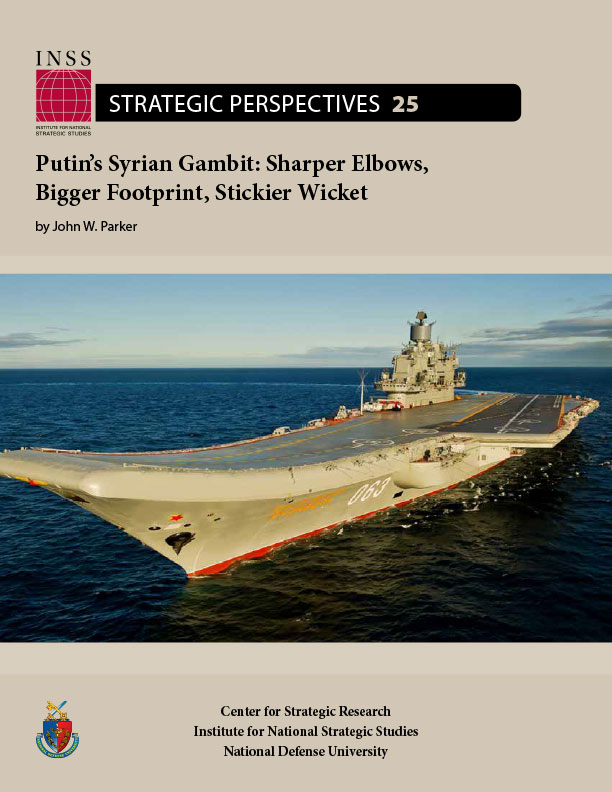DOWNLOAD PDF
Executive Summary
 Thanks in large part to Russia’s military intervention, Syrian president Bashar al-Asad’s
fortunes have made a remarkable recovery since May/June 2015. Russia, together with the Lebanese
Hizballah, Iran, and Iranian-organized Shia militias from Iraq, Afghanistan, Pakistan, and
elsewhere, has succeeded in averting Asad’s military defeat. What Russian president Vladimir
Putin has accomplished in Syria is important for American national security interests and policy
in the region because it frames some of the hard choices Washington must now make.
Thanks in large part to Russia’s military intervention, Syrian president Bashar al-Asad’s
fortunes have made a remarkable recovery since May/June 2015. Russia, together with the Lebanese
Hizballah, Iran, and Iranian-organized Shia militias from Iraq, Afghanistan, Pakistan, and
elsewhere, has succeeded in averting Asad’s military defeat. What Russian president Vladimir
Putin has accomplished in Syria is important for American national security interests and policy
in the region because it frames some of the hard choices Washington must now make.
Russia has profited from a hard core of Alawite and Christian support for Asad inside
Syria. At the same time, U.S. reluctance to become militarily involved in Syria facilitated the
move of Russian forces into the country. Russia also benefited from the disunity among the
diverse opposition to Asad and their external patrons. While Saudi Arabia and Turkey were
both early proponents of ousting Asad, Saudi Arabia is now more focused on defeating Houthi
rebels in Yemen, and Turkey on fighting Kurdish separatist forces in northern Syria. In return
for help from Putin in resolving its Kurdish problem, Turkey in 2016 helped Putin resolve Russia’s
Aleppo problem.
As President Donald Trump considers and implements a way forward on working with
Russia in the fight against the Islamic State of Iraq and al-Sham (ISIS) and toward peace in Syria,
events of the past several years underscore several fundamental constraints under which Putin
will be operating and some challenges that have been overstated.
First, Russia will find it hard to deliver Asad’s agreement to any political arrangement that
requires him to step aside to bring the conflict to an end. Asad plays Russia off against Iran and
the Lebanese Hizballah, placing them all on the same level and extending no preference to Putin
for Russia’s contribution to his survival.
Second, Tehran will not be keen to see its leverage in Damascus diminish and that of Moscow
grow. Tehran will support Asad in his resistance to any Russian pressure that would impact
what Tehran sees as its existential interests in Syria as a vital link in Iran's land bridge to the
Lebanese Hizballah.
Third, while working with Iran militarily in Syria, Russia has successfully pursued engagement
with most major Sunni powers in the Middle East, most interestingly Saudi Arabia, as well
as with Israel. However unpopular on “the street,” Putin and Gulf Sunni royals appear to have
no complexes about dealing with each other.
Fourth, Putin does not want Syria to be a “negative” issue going into the next Russian
presidential elections, scheduled for March 2018. This may be the major reason he has wanted to “solve” Aleppo so quickly in 2016 and pivot again to peacemaking efforts more prominence.
Cooperation with the Trump administration and renewed American treatment of Russia as a
“respected equal” would make Syria a more manageable electoral issue for Putin.
As Washington continues to formulate and fine-tune a new approach to fighting ISIS and
terrorism under the Trump administration, this study makes the following policy recommendations.
First, the United States must cast aside sentiment and strictly prioritize its objectives
and preferred or acceptable outcomes.
Second, the United States should work toward a Syria that remains unified even as the
American fight against ISIS benefits from Syrian Kurdish military prowess. The Kurds should be
part of the mix in political negotiations going forward but only in the context of a unified Syria
at the end of the process.
Third, the United States should explore the military pros and cons of more robust cooperation
with Russia in Syria, without conceding anything in advance on Asad’s future or Iran’s place
in the region. As it did on April 7, 2017, in response to Damascus’s sarin gas attack on Khan
Shaykhun, the United States needs to be prepared selectively and judiciously to strike at Syrian
regime forces from time to time to inhibit their attacks on nonterrorist opposition fighters and
civilian populations.
Fourth, Washington should work quietly with Moscow toward diminishing Iranian leverage
in Syria and the region. That said, while Moscow probably hopes that its weight in Syria
will increase over time at Iran’s expense, Russia has little interest in sharing its influence gains
in Syria with the United States.
Finally, with or without Russia, the United States should engage militarily in Syria more
robustly. Besides being necessary to fight ISIS more effectively, this will also help reverse the
view that began to take hold in the region during the Barack Obama administration that the
United States is a declining power, and encourage regional capitals to rebalance their relations
with Moscow.
This paper is based on information that was current as of June 6, 2017.
READ MORE >>